Now that I’ve explained the basics of the carbon cycle and why it’s important to understand the fate of carbon from thawing permafrost in my last post, let’s talk about what the team is learning about the role of sunlight in this process.
The team recently made an important discovery – that when permafrost thaws and exposes previously frozen carbon to sunlight, that carbon becomes much more susceptible to being converted to CO2 by microbes than carbon that is kept in the dark. In fact, according to the team’s results, exposure to sunlight will increase conversion to CO2 by an additional 40% or more. This is important because right now, the tundra IS thawing, exposing previously frozen carbon to sunlight. To better understand climate change, it’s important to know the fate of this carbon, and how likely it is to be converted to CO2.
This discovery made a major impact on the scientific community earlier this year. Rose Cory, George Kling and their colleagues published their findings in the Proceedings of the National Academy of Sciences, and were also reported on in magazines and newspapers.
One way previously frozen carbon is being exposed to sunlight is through thermokarst activity. What, you ask, is "thermokarst"? It’s a failure or landslide in permafrost soils that happens as the tundra thaws. On Lake NE14, near Toolik, a large thermokarst failure appeared in 2006 and the team has been studying it closely over the past 7 years.
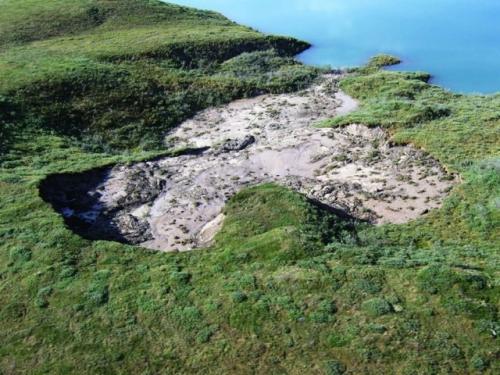
Arctic temperatures are warmer than in the past and are likely to get even warmer, leading to more and more thermokarst features in the future. The thawing tundra will release carbon from the vast pool of organic matter currently frozen in permafrost, and some of this carbon will be converted to CO2, making the climate even warmer. The team’s discovery -- that this thawing carbon is more likely to be converted to CO2 than we previously thought, will help scientists understand climate change and make predictions about the future.
But How Do We Know?
You might be wondering, exactly how did the team make this discovery? The answer, as I’m learning here at Toolik, is that the team collects an enormous number of samples year after year, all over the tundra, and does a tremendous amount of innovative lab work to test its hypotheses and arrive at conclusions. For example, the team is still sampling the NE14 thermokarst, 7 years after it happened. Here’s a picture of how it looks now, from our sampling trip there last week.
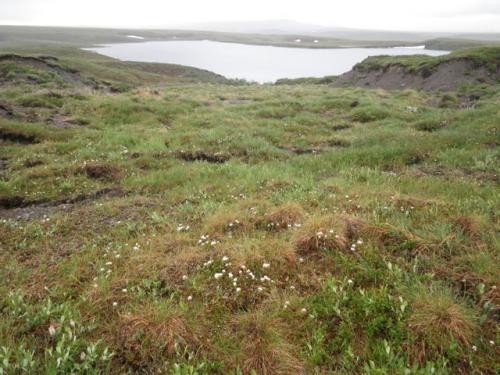
It’s getting vegetated, but you can still see bare soil exposed to the sun.
To study the effect of sunlight on microbial conversion of carbon to CO2, the team first collected water samples from lakes and rivers and then filtered them to remove all the microbes.
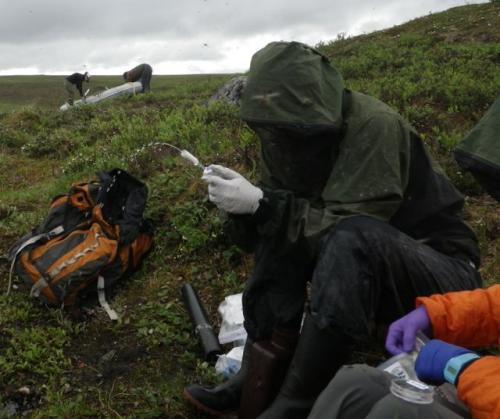
After filtering, the water still contained dissolved organic mater (carbon compounds), but no microbes. This microbe-free water was then placed into small plastic bags and left out in the sunlight for less than a day. The energy from the sun acts on the carbon compounds, changing their composition and/or structure. Another “dark bag” with the exact same water is kept in the dark, as an experimental control.
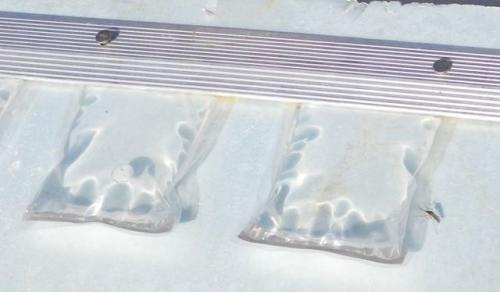
After the water has been exposed to the sunlight, the water from both the dark bag and the sun-exposed bag are fed to microbes, and the team measures the rate at which each microbial community grows and expels CO2. Based on this experiment, the team found that the microbes which were fed water exposed to sunlight produced up to 40% more CO2 than the microbes fed the dark control, demonstrating the importance of sunlight in this process.
It isn't know exactly what changes take place in the carbon molecules that make the microbes seem to prefer sun-exposed carbon more, but clearly there is a change that takes place, and it promotes the production of CO2.
If this is confusing to you, these pictures might help. They show how sunlight affects common beverages, similar to the way sunlight breaks down carbon compounds in lakes and rivers to make them more available to microbes.
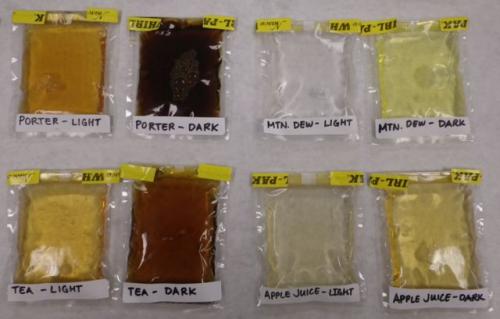
This experiment was put together by Jason, a research assistant on the team, on the roof of the lab here at Toolik. For each liquid he tested he used two bags, and placed one bag in the sun and one in the dark, as a control. In each pair, you can see the dark control on the right and the sun-exposed liquid on the left. Clearly, the sun affects the liquid, causing some kind of chemical change causing it to get lighter.

But here’s a question for you – why do Coke, Orange Crush and Mountain Dew go completely clear in sunlight, while tea, apple juice, and porter beer only get lighter but not completely clear?


Comments